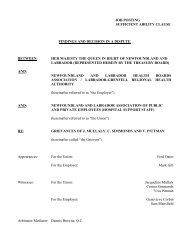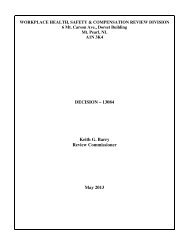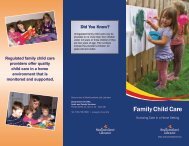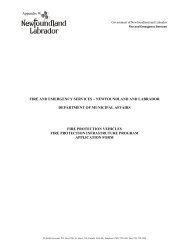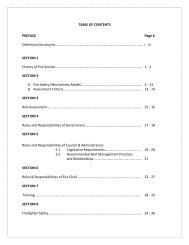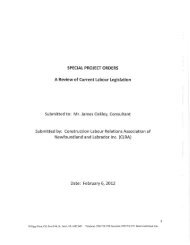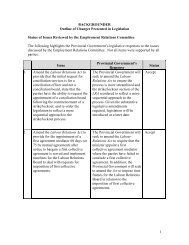Basic Level Pre-Course Reading
Basic Level Pre-Course Reading
Basic Level Pre-Course Reading
You also want an ePaper? Increase the reach of your titles
YUMPU automatically turns print PDFs into web optimized ePapers that Google loves.
Chapter 5<br />
Control the Situation<br />
Emergency Washdown can be water sprayed from fog nozzles over victims from<br />
one or more fire trucks. A high volume of water at a low pressure is required (See<br />
Figure 9).<br />
Figure 9<br />
Spraying Water from Fog Nozzles for Emergency Washdown<br />
In order to most efficiently activate the Emergency Washdown process,<br />
responders should follow these guidelines and direct casualties to:<br />
1. Exit to the holding area - use scene tape, rope, vehicles, pylons, etc. to<br />
create a physical corridor which ushers people toward the entrance of the<br />
Emergency Washdown set-up.<br />
2. Remove clothing carefully to prevent contamination from clothing to<br />
skin - care must be taken to limit the spread of contamination when removing<br />
and handling clothing and footwear. Casualties can be directed to assist each<br />
other. (Note - testing with simulated chemical agents shows that the removal of<br />
clothing can remove most of the contaminants up to 80%.)<br />
3. Avoid blotting or scraping - this may in fact drive certain types of agents<br />
into the skin.<br />
4. Place removed clothing and personal items in double plastic bags if<br />
practical and/or feasible - in order to both limit the spread of contamination and<br />
to preserve evidence, these items should be collected and controlled.<br />
5. Walk through the water spray with arms and legs apart and head back -<br />
this helps to clean more quickly.<br />
6. Wash from the top down - if soap and water are available, casualties should<br />
be instructed to lather thoroughly and follow with rinsing. (Note: soap and water<br />
may NOT destroy CBRN agents but rather remove and dilute them.)<br />
7. Avoid swallowing water and avoid getting anything but the direct spray<br />
into the face.<br />
CBRN First Responder Training Program<br />
48<br />
<strong>Basic</strong> <strong>Level</strong> <strong>Course</strong>



